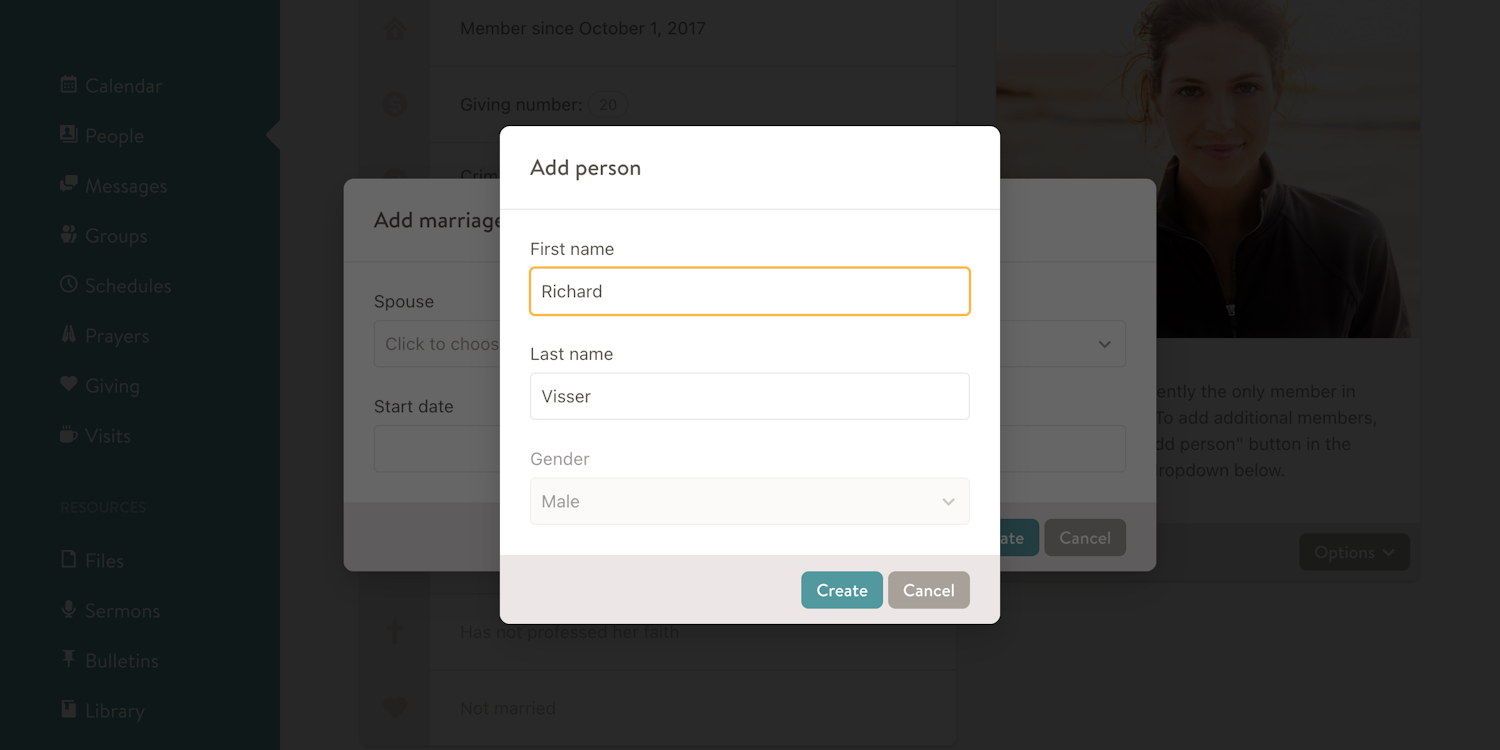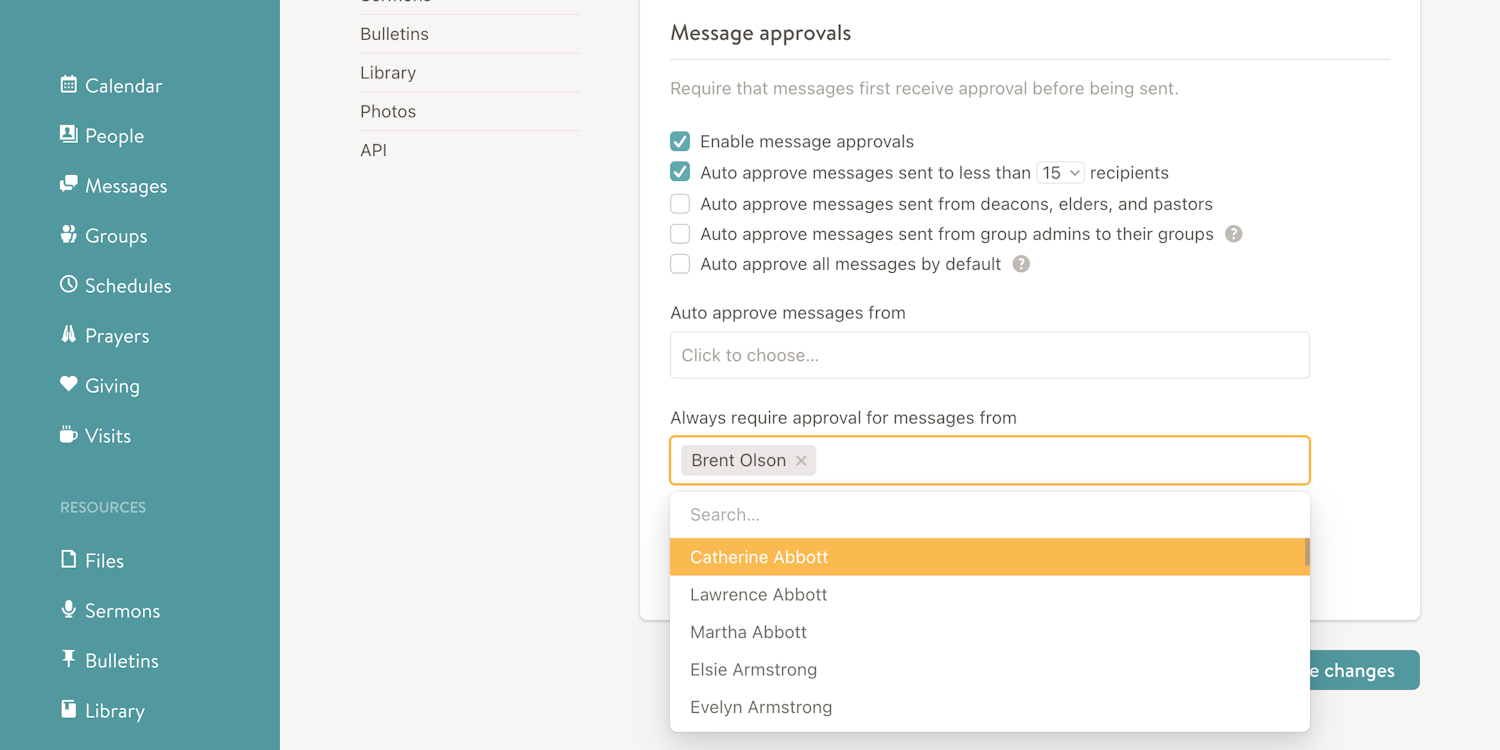Calendar now shows time and location

We've just made a helpful little improvement to the calendar — it now shows the time beside events and visits, and if you hover over an event, it will also show the location (if one is set). This makes it easier to find this information without having to click through to view the event or visit page.
New "groups" attribute in family report builder

We've added a new Groups attribute to the family report builder, allowing you to:
- List all the groups that the family is in
- Filter families by the groups they are in
- Sort the families by the groups they are in
- Group the families by the groups they are in
This attribute was previously available in the people report builder and is now available for family-level reporting as well.
Added background check renewal instructions to reminder emails

Churches can now include custom instructions in background check expiration emails to help members understand how to properly renew and submit their checks.
Two new Safe Church settings are available:
- Criminal record check instructions
- Working With Children check instructions (shown for Australian churches)
These details appear at the bottom of the monthly expiration reminder emails, following the standard renewal notice, allowing churches to share local requirements, next steps, contact information, or other helpful guidance with their members.
Fixed schedule reminders for inactive children
We fixed a small bug where parents could sometimes receive email reminders for their children’s scheduled tasks even when those children were no longer active members.
This applies to schedules where parents are emailed reminders on behalf of their children (commonly used when a child doesn’t have an email address). These reminders are now only sent for children who are active members of the congregation.
Adjustments to how deceased family members are shown

In an effort to be especially mindful of families who have lost loved ones, we have made several adjustments to how deceased family members are displayed on the family page in Church Social.
First, these members are no longer shown with a “Deceased” status. Instead, their status now appears as “Past Member,” and a small cross (†) is displayed next to their name.
Second, these members are no longer grayed out. Previously, all family members without an active membership within the congregation were shown this way.
Third, we now always show the birth date for these members, regardless of privacy settings, to better reflect how this information is typically shared in obituaries.
We hope that these subtle changes make it easier for families who are mourning the loss of loved ones.
In addition to these updates, we’ve also adjusted the family page to always show all other inactive family members to office-bearers, without needing to press the “Show inactive” button. In hindsight, this extra step wasn’t necessary.
Send messages from groups

We're excited to announce the release of a long-requested feature in Church Social — sending messages from groups! If you've ever wanted to send a message on behalf of a committee, Bible study, council, or consistory — and have that group’s name appear in the subject line instead of your own — that's now possible!
Until now, every message sent from Church Social always came from the individual sender. The subject line would appear as “Your Name: Your Subject,” with no way to show a different sender. While this encouraged a high level of accountability — people tend to be careful with what they send when their name is attached — in practice it didn’t always reflect who the message was actually from, and could make members feel like communication was “too much about them.”
To send messages from a group, you must be one of that group’s administrators, and the group must have an email address set. For example, for your church council group, you might make your council clerk the administrator and set the email address to something like [email protected]. This email will be used as the reply-to address when people respond to messages sent from the group. You can add group administrators and assign email addresses from the “Edit Group” page in the Groups area of the app.
After you add an email address to a group, its administrators will see that group as a “From” option when composing new messages.
A nice benefit of this change is that members can now unsubscribe from messages sent by specific groups, instead of being limited to unsubscribing from an individual sender. So if someone isn’t interested in messages from a particular group, they can now opt out more easily.
Finally, to maintain accountability when sending group messages, you can still see who actually sent it. This appears in small text at the bottom of the outgoing email and is also shown subtly on the message page in the app.
We hope this change improves your member-to-member communication!
Improved file folder permissions

We've made a number of big improvements to how file folders work in Church Social!
More flexible permissions
Previously, you could only give one group access to a file folder, and only one person or group permission to edit it. That was pretty limiting!
Now you can grant file folder access to multiple people and groups. You can also choose whether each one is a viewer (the default) or an editor.
For example, a council or consistory folder might allow all elders and deacons to view the files, but only the council clerk and chairman to edit them.
Administrator access changes
Church Social administrators no longer have access to every file folder by default. This means sensitive folders — like council or consistory folders — stay private unless access is explicitly granted.
However, administrators can still manage folder permissions when needed (for instance, if a folder ends up with no remaining editors).
New folder descriptions
You can now add an optional description to a file folder. This text appears at the top of the folder's page and is great for adding context or instructions for your members.
File trash improvements
We've also streamlined the file trash:
- The trash is now located in the three-dot menu at the top right of the Files page (it's no longer shown at the bottom of your folder list).
- Trashed files are automatically deleted after six months, helping keep things tidy.
We hope these updates make managing your church's files in Church Social simpler, safer, and more flexible!
Fixed dialogs closing unexpectedly
We've fixed two related issues that could cause dialogs to close when they shouldn’t:
- Pressing escape while using a date picker or autocomplete input no longer closes the dialog.
- Clicking an option in a dropdown that extends outside the dialog area no longer closes the dialog.
Added new “22 and older” age filter to the Safe Church page

We’ve added a new “22 and older” age filter to the Safe Church page for churches that track this information based on age 22 and older, rather than 18 and older.
Added support for HEIC images
You can now upload HEIC images — a format commonly used on Apple devices — when adding photos to your family profile or the photos area.
Add new people records when assigning spouses and parents

One question we sometimes hear is: “What do I do if I want to record a marriage, but the spouse isn’t in our church records?” The answer has always been to create a new person record for that spouse, even if they’re not a member. This works well, since you can then add additional information to their profile (for example, a date of death for a former spouse).
But this path hasn’t always been obvious. To make it clearer, we’ve added a new “Add person” button right beside the spouse input in the marriage dialog. This lets you quickly create a new person record and have it automatically selected as the spouse, making the intended workflow much more clear.
We’ve also added the same button to the father and mother inputs. While this comes up less often, it can still be helpful in certain cases.
And don’t worry — since these are non-member records, churches are never charged for these additional people.
Always require approval for messages from specific people

We’ve added two new options to the message approval feature in Church Social:
- Always require approval for messages from — This option is the opposite of Auto approve messages from. When enabled, any messages sent by people on this list must always be approved by a message approver, no matter what other auto-approval settings are in place. This is especially helpful in situations where certain members pose a risk of sending inappropriate messages to the congregation.
- Auto approve all messages by default — This option makes all messages auto-approved unless the sender is listed in the Always require approval for messages from option. It’s useful if you only want to enforce approvals for a select few individuals, while leaving all other messages to go through automatically.
These options should help churches ensure that all messages sent through Church Social remain appropriate and edifying for the congregation.
New "Fund totals with method totals" contribution statement

We’ve added a new "Fund totals with method totals" contribution statement to the giving area. This report works just like the existing Fund totals statement, but also includes a breakdown of the payment methods used for each fund, displayed directly below each fund total.
New option to duplicate deposits

Treasurers can now quickly duplicate an existing deposit, including all its contributions, with a new date. This is especially handy for recurring contributions, like monthly pre-authorized deposits. You'll find this option on the deposit page in the three-dot dropdown menu.
More flexible schedule reminders

When creating or editing a schedule, you can now set reminder emails to go out 3 weeks (21 days) or 4 weeks (28 days) in advance. This gives churches more flexibility to notify members about upcoming tasks earlier. While reminders closer to the task date are usually most effective, in some cases sending a first reminder several weeks ahead can be helpful.